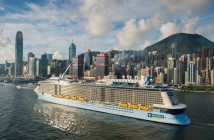Asians have taken to cruising like no other region, and the cruise industry is scrambling to keep up with demand, a new report into cruise trends in the region shows.
The report confirms Asia as the world’s fastest growing source of cruise passengers, with an unprecedented 24 per cent increase in numbers last year.
Most cruise within Asia – eight out of ten chose to stay in the region, and only 16 per cent travelled to Europe and other areas.
And many are much younger than their American and European counterparts, with 40 per cent under 40 years old.
The growth in luxury cruises has been particularly strong, and a number of ships will be visiting this year.
The 2016 Asia Cruise Trends study released today by Cruise Lines International Association (CLIA) shows 24 per cent growth and no signs of the market slowing.
Indeed, most believe as there is more promotion, things will speed up!
The data came from 31 international and regional cruise lines.
Asia experienced the most growth from cruisers – tens of thousands of new cruise passengers decided to give cruise holidays a try.
Ocean cruising was the most popular between 2014 and 2015.
More than 2.08 million passengers sailed in the region last year.
“Even we were surprised by 24 percent growth and that is unprecedented,” CLIA head Cindy D’Aoust emphasizes. “We see no signs of slowing down.”
CLIA North Asia chair Dr Zinan Liu said: “While we expected Asia to experience record-breaking growth in cruise travel, we are astonished at the rate at which the region is emerging as one of the most significant cruise destinations and cruise source markets in the world.”
- More than 1,560 sailings are scheduled throughout Asia for 2016 – up 43 percent from last year.
- The number of days that cruise ships operate in Asia has risen from 4,307 in 2013 to 7,918 in 2016.
- Sixty ocean cruise ships will sail throughout Asia this year, eight more than in 2015.
- Fourteen operate year-round while another 12 have extended deployment in Asia.
Cabin numbers soured by more than half, with CLIA saying overall passenger capacity on ocean cruise ships will reach 3.2 million in 2016.
Asia can now boast 204 cruise destinations across 17 countries, with Japan no 1.
Japan 1,526 port calls in 2016.
China had 850 calls
South Korea had 745
Vietnam had 466
Malaysia had 422
Singapore at 391.
Ms D’Aoust told American travel agent web sites the growth in port destinations is a big opportunity. She urged agents to talk to clients about the new port options.
“It [Asian cruising] also provides a very easy and comfortable environment for travelers to check off their bucket list,” D’Aoust tells Travel Agent. “For experienced cruisers who’ve never had that opportunity [to visit some Asian bucket-list ports], there’s an entirely new market.”
Jeju Island, South Korean, is the most visited port in 2016 with 460 calls, beating China’s monolithic port Shanghai with 437 calls, Singapore at 391 calls, and Fukuoka, Japan, at 258 visits.
After enormous numbers of ships calling there, China’s passenger numbers have grown at an annual compounded rate of 66 percent – growing an amazing 40 per cent last year alone.
Last year, 986,000 passengers were from mainland China, representing close to half of the Asian volume, compared to 703,000 in 2014.
Almost three out of ten Asian cruisers continued to choose two to three night journeys with 50 percent taking four to six night cruises.
Just under 20 per cent took extended cruises of seven to 13 nights.
Commenting on the study, CLIA Australasia Managing Director Neil Linwood said the strong growth in the Asian region was good news for the local Australasian cruise industry.
“The growing number of people in Asia discovering the joys of a cruise holiday, means more potential customers for cruise ships sailing in our waters. It also opens the way for more ships, including newer and larger ships, to be deployed in Australia seasonally, complementing their Asian deployments,” Mr Linwood said.
American site Travel Agent asked Ms D’Aoust if exposing more Asians to cruising will have the effect — as has been the case in the U.S. – of people taking regional cruises first, but then as they become more experienced and more exposed to cruising as a vacation choice, going farther out – say to the Caribbean or Europe.
With more passengers patronizing voyages outside Asia that could increase demand and, over time, keep pricing at a good level. “Absolutely,” D’Aoust responds. “We don’t look at one market into itself.“
She said that while right now most Asian cruisers prefer to travel within Asia, there is still a good outbound market that prefers seven- to 13-day cruises.
So they may start with Asia, but then head to the Mediterranean, Baltic or elsewhere in the world. “We don’t see any obstacle to that growth,” she notes.
In China, the average age of cruisers is below 43 — with about 42 percent of cruise travelers below 40 years old. For the region, the same segment represents 38 percent of all cruisers.
This year, 31 cruise brands are active in Asia with 60 ships. The lines will operate 1,560 cruises this year, versus 1,095 in 2015. Total Asian cruise passengers this year will be 3.1 million, up from 2 million a year ago.
Most capacity, not unexpectedly, is on mega-ships – with two in the region – as well as on 15 large ships. Twenty-one mid-sized ships will sail in Asia, plus 16 upscale smaller ships and six expedition ships.
Asia-to-Asia cruises and short cruises will dominate the itineraries. More than 1,473 voyages are planned. Another 87 voyages will “pass through” the region.
Nearly 50 percent will be four-to-six-night cruises, while nearly 38 percent will be two-to-three-night cruises.
Some 5,500 port calls are scheduled this year in Asia. Japan, China and South Korea will welcome the most calls. Sixteen Asian ports will each host more than 100 calls this year.




